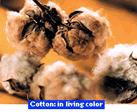
Can the fashion-conscious have an ecoconscience? Designer Isaac Mizrahi would probably say yes, given that the dresses in his fall collection are accented with recycled furs. So would Giorgio Armani — he created the hemp tux Woody Harrelson wore to this year’s Oscars.
But pose the question to environmental purists and they’ll tell you that, for the most part, the catwalk is a real dog when it comes to ecofriendliness, and if you truly want an outfit that matches your green sensibilities, buy used.
Clothes manufacturing wears on the planet. Twenty-five percent of the insecticides used globally go on cotton plants, grown for the world’s most popular fabric. Synthetics, like polyester, are made from petroleum products and are nonbiodegradable. And fabric-finishing processes such as dyeing are highly toxic and polluting.
So, if the creation of clothing has a negative impact on the environment, what then is behind all the green-labeled clothing on the market? Let’s take a look at the cloths many of these clothes are cut from:
ORGANIC COTTON Organic cotton is grown using chemical-free, soil-enriching methods, but its use in manufacturing doesn’t guarantee ecofriendliness. Even companies, such as Patagonia, that exclusively use organic cotton still use color dyes. “Dyes are as bad, if not worse, than the agricultural chemicals,” says Sally Fox, an entomologist who grows colored organic cotton (above) for her company, Natural Cotton Colours Inc.
Patagonia is well aware of this criticism, but responds that it’s promoting the first steps of change. “If no one buys the product,” explains Lu Setnicka of Patagonia, “you’re not going to build an organic cotton market.”
HEMP Durable and versatile, hemp can be grown without chemicals and does not deplete soil. And consumers have been snapping up hemp fashions. However, industry experts say those hemp jeans you paid so much for may have been “greenwashed.” Since it’s illegal to grow hemp in the U.S., it’s imported, primarily from China, Hungary, Romania, and Russia — which aren’t exactly ecopioneers.
According to Owen Sercus, a textile professor at New York’s Fashion Institute of Technology, hemp producers in these countries are using harsh chemicals to speed up the growing process. “If hemp is properly grown by nature,” he says, “it takes a long time.”
TENCEL Tencel is a natural fiber created from wood pulp using a nontoxic, “closed loop” process that recycles solvents. Additionally, the pulp is only taken from trees grown on managed tree farms.
Unfortunately, the EPA lists Courtaulds Fibers, the manufacturer of Tencel and other fiber products, as the sixth-largest polluter in the country, having released 34.5 million pounds of toxins into the environment in 1994. (Guess some things escaped “the loop.”)
RECYCLED POLYESTER Fortrel EcoSpun is a polyester made from recycled plastic containers. Its manufacturer, Wellman Inc., says the production of EcoSpun saves 650,000 barrels of oil annually, while eliminating 375,000 tons of toxic air emissions. The material is made into jeans and Polar Fleece (which are, of course, dyed).
Clearly, all fabrics have a downside. But remember, the fabrics and finishes are there because consumers want cheap, easy-to-care-for clothing. Oh, and we also want to express ourselves. “Do we want to end up like Maoist China, where everybody wore the same garment?” Sercus asks. “We in the fashion industry do what the consumer demands of us.”
So, if you want your clothes to be green, demand it. If you want to know why a company has slapped an “ecolabel” on a garment, ask. And, if all else fails, there’s one surefire way to style yourself while minimizing environmental harm: Head to the secondhand store and grab that polyester leisure suit off the rack.















